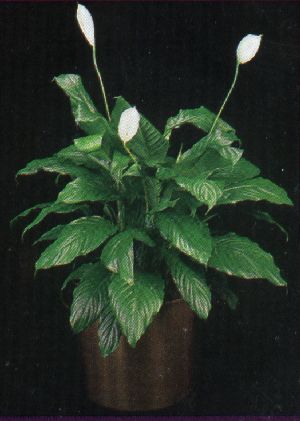
 |
|
|
Do you ever think if the air inside your home is dirty? Have you thought of the possible hazardous pollutants that could be floating around inside your home right now? Do you suffer from asthma or allergies on a regular basis? If you have answered yes to any of the above questions, you might want to know the benifits of having houseplants in your home or office.
Did you know that simple building materials such as plywood, carpeting, paint, upholstery, wallpaper and hundreds of other synthetic products release volatile organic compounds referred to as (VOC's). You will be shocked when you find out that formaldehyde, trichloroethylene (TCE), xylene, toluene, ammonia, acetone, methyl alcohol, ethyl acetate and benzene are among the ammited compounds that are present in the air you live in.
In recent years construction of homes and buildings have improved to make them more efficient; this makes the building more "air-tight" which often traps gases from the aforementioned synthetic materials that can pollute the indoor air. These air pollutants can cause problems for inhabitants especially during the winter when people are forced to spend a great deal of time indoors. Many people think that air purifyiers and air filters will do the trick, but these mearly remove dust and pollen from the air. They have nothing to do with removal of pollutants.
According to the Environmental Protection Agency, indoor pollution is one of the top five environmental health threats in America. It is also the main culprit for the 60 percent increase in cases of asthma in the last decade. Also the buildup of VOC's can cause "sick building syndrome," as it is called which includes allergies; fatigue; headaches; respiratory problems; and eye, nose, and throat irritations. It is said that the air inside our homes is has 25 to over 100 times the pollutants as outside air.
Scientists at NASA have done extensive research with plants and their ability to maintain clean air in lunar bases. In 1984, NASA senior research scientist Dr. Bill Wolverton tested houseplants for their ability to maintain clean air for future habitable lunar bases. He tested in sealed chambers and found that philodendrons and golden pothos were excellent formaldehyde controllers. Gerbera daisy and chrysanthemums were proved to be impressive benzene purgers. Pot mums and peace lilies were tested and rated high for TCE removal. His initial findings suggested that one to three mature plants were enough to improve the air in a 100-cubic-foot area.
People shy away
from growing houseplants because they are afriad they will not know how
to take care of them and think it is expensive and time consuming to care
for them. Most houseplant are relatively easy to take care of and inexpensive
if bought at your local greenhouse. They also liven up the space you are
living in, so why not check a few of the top ten out to see which ones
you prefer. Dr. Wolverton's personal favorites are the lady palm, peace
lily and "Janet Craig" dracaena, "because they're easy to grow, resist
insects and work wonders" for a variety of pollutants.
 |
|
|
Many of the
recommended plants will add life to your home or work space. The one thing
you will be thankful for is you will have clean air to help you work and
live healthier, after your houseplants have cleaned the air from the sickening
pollutants that occupy your air. If you live in a newer home you will begin
to see the improvement of the quality of air as your allergies and eye
irritaitons will cease. So, weather you believe NASA or not, the addition
of a few eyecatching plants can be good for your health.
The Top Ten Houseplants that clean the air are as follows: |
| 1. Areca Palm |
| 2. Lady Palm |
| 3. Bamboo Palm |
| 4. Rubber Plant |
| 5. Dracaena "Janet Craig" |
| 6. English Ivy |
| 7. Dwarf Date Palm |
| 8. Ficus Alii |
| 9. Boston Fern |
| 10. Peace Lily |
References